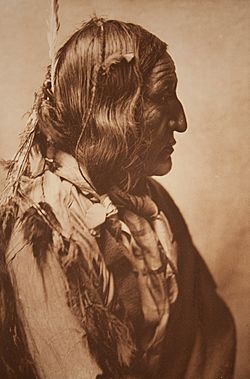Battle of Turkey Springs facts for kids
Quick facts for kids Battle of Turkey Springs |
|||||||
|---|---|---|---|---|---|---|---|
 Little Wolf |
|||||||
|
|||||||
| Belligerents | |||||||
| U.S. Army | Cheyenne Indians | ||||||
| Strength | |||||||
| 86 soldiers; two Arapaho scouts | 92 warriors | ||||||
| Casualties and losses | |||||||
| 3 killed, 3 wounded | 5 wounded | ||||||
The Battle of Turkey Springs was a fight between Native Americans and the United States Army. It took place on September 13–14, 1878, near what is now Freedom, Oklahoma. This battle was part of a larger journey known as the Northern Cheyenne Exodus. About 350 Cheyenne people, including warriors, women, and children, were trying to leave their reservation in Oklahoma. They wanted to return to their homeland in the northern Great Plains. During this battle, the Cheyenne fought against U.S. soldiers and won, allowing them to continue their journey north. It was the last battle between Native Americans and the U.S. Army in Oklahoma.
Contents
Why the Cheyenne Left the Reservation
For many years, the Cheyenne tribe had two main groups: the Northern Cheyenne and the Southern Cheyenne. In 1876, two important Northern Cheyenne chiefs, Dull Knife and Little Wolf, and their followers were defeated by the U.S. Army. They later surrendered at Camp Robinson, Nebraska.
In 1877, these Northern Cheyenne were forced to move. Soldiers escorted them about 1,300 kilometers (800 miles) south. They went to a reservation in Oklahoma where the Southern Cheyenne lived. About 937 Cheyenne people arrived at this new reservation. It was located near Fort Reno, about 50 kilometers (30 miles) west of modern-day Oklahoma City.
Life on the reservation was very hard. There wasn't enough food for everyone. Many people got sick with diseases like measles and malaria. Chiefs Dull Knife and Little Wolf asked if their people could go back to their northern homelands. Their request was denied.
So, in September 1878, the two chiefs and 350 of their followers decided to leave. They planned to travel north to join other Northern Cheyenne groups, mostly in Montana. Out of the 350 people, 92 were warriors. The rest were women, children, and elderly people.
The Army's Pursuit
On September 10, 1878, a U.S. Army captain named Joseph Rendlebrock began to chase the Cheyenne. He had 85 soldiers and two Arapaho scouts with him. They left from Fort Reno. Captain Rendlebrock hoped to catch the Cheyenne near the Arkansas River in Kansas.
However, the Cheyenne were well-mounted and moved quickly. Instead of being caught, they were waiting for the soldiers. The Cheyenne had stopped at a waterhole called Turkey Springs. This spot was in a hilly area near the border of Oklahoma and Kansas. Before the army arrived, the Cheyenne had encountered and killed two cowboys nearby.
Fighting at Turkey Springs
On September 13, Captain Rendlebrock and his soldiers found the Cheyenne. They saw Cheyenne warriors on a hilltop. The captain arranged his soldiers in a line ready for a fight. He sent an Arapaho scout named "Chalk" to talk to Chiefs Dull Knife and Little Wolf.
Chalk told the Cheyenne leaders that they must return to the reservation. But the chiefs refused to go back. Cheyenne warriors then started to move around the sides of the soldiers. The soldiers began to fire their weapons, and the Cheyenne fired back. They used their ammunition carefully because they didn't have much.
The fighting continued throughout the day. During this time, two soldiers were killed, and three were wounded. After it got dark, the soldiers were very thirsty. Seven of them tried to get water from the springs, but they couldn't reach it.
By the next morning, September 14, the Cheyenne had completely surrounded the soldiers. Captain Rendlebrock ordered his troops to retreat. They moved through ravines, with Cheyenne warriors firing down at them. Another soldier was killed during this retreat. Rendlebrock's group retreated about 15 kilometers (9 miles) to the Cimarron River. The Cheyenne had five people wounded during the battle.
After the battle, the Cheyenne split into several smaller groups. This made it harder for the army to track them. They continued their journey northward. Captain Rendlebrock was later put on trial by the army for his disorganized retreat.
The Journey Continues
The Cheyenne kept moving north after the Battle of Turkey Springs. They fought and won several more small battles against the U.S. Army. They also killed seven cowboys in southern Kansas. In total, about 1,300 soldiers and some civilians tried to capture them.
When they reached Nebraska, the Cheyenne split into two main groups. Little Wolf led the stronger, more able-bodied people. This group successfully reached and joined the Northern Cheyenne in Montana.
Dull Knife led a smaller group. This group was captured and held at Camp Robinson. In January 1879, during very cold weather, 149 Cheyenne escaped from Camp Robinson. They fled westward, but soldiers chased them. Almost all of these escapees were either killed or captured.
In the end, the survivors of the Northern Cheyenne Exodus were allowed to stay in their homeland on the northern plains.

